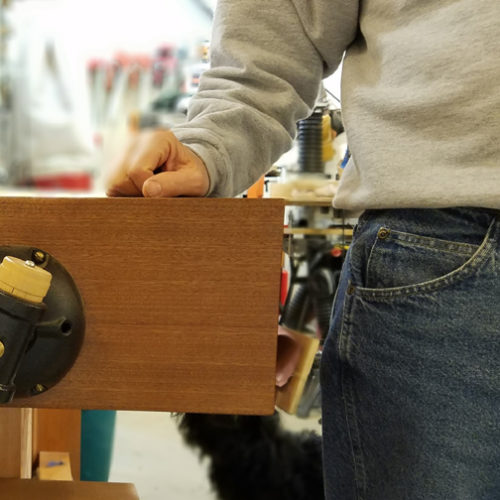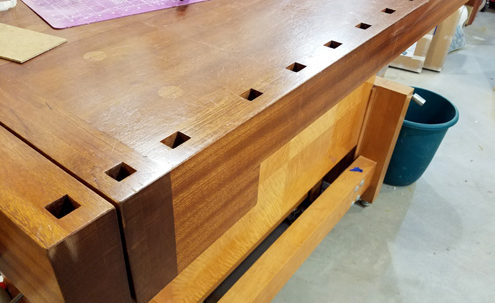A work bench is an important part of a wood workers garage or workshop. It should be sturdy, easy to work with, and help make your shop time more enjoyable.
Here are a few common mistakes you should avoid while designing and building your workbench. I hope this is helpful!
1. Height
Workbench height is critical. Traditionally, people say that the bench height should be even with the knuckles on your hand when your is arm hanging by your side. That may be good for heavy hand work, but for most modern work that is too low. For most operations, the height should be close to waist height. I think my Adjustable Height Workbench is the best of all worlds. I can adjust it high for carving, marquetry, and other detail work. And I can adjust low for hand planning and even lower for assembly work. It is also nice to have an adjustable height bench so that kids, and grandkids, can comfortably work at it, too.

A realistic workbench height is about waist high
2. Wood Types
Many people spend a lot of time worrying about what type of wood to use, when in reality just about any type will be fine. Depending on your needs you could even use plywood, but personally I would not use plywood for the top. You want wood that is affordable, heavy, and easy to obtain. Most importantly, the wood should be dry. Wood that isn’t seasoned tends to warp and is more trouble than it’s worth.
3. The Wrong Vice
You will get used to whatever vise you have, but it’s nice to have a good high quality vise. Personally, I want my main vise to be either fast acting, or quick release. I am also so, so glad that I have an end vise on my bench. It is great for clamping things in between the dog holes. Also consider the type of work that you do. If you do a lot of carving then maybe a dedicated carving vise or even a pattern maker’s vise would be right for you. I get annoyed by people who say that this vise or that bench is the right for everyone. Sure, there are standard vises and standard configurations but it is YOUR bench and you should build it to suit yourself.
4. Dog/Holdfast Holes
Think about your specific end vise before deciding how far to space your dog holes. If you have a fast acting or quick release end vise then you can space the dog holes further apart, maybe 6″ or so. But, if your end vise takes a lot of turns to move a few inches then space them closer together, maybe about 4″ apart.
Holdfast holes are different. Put a few of them where you expect to do most of your work, and drill a few more later if you need them.

Dog holes spaced fairly close together
5. Waiting For Just The “Right Time”
I am the king of procrastination and sometimes I get analysis-paralysis. I am getting better about this and when I finally do get going I usually realize that I should have just dug in and got started! Don’t get me wrong, I am a big believer in getting your ducks in a row. And, my projects ALWAYS go better when am prepared. The go even better when I draw up a set of plans before starting. What I am saying is Just Do It!
6. Needing to Think I Can’t Build it Without “XYZ” Tool
This is similar to #5, waiting for just the right time. I LOVE tools and the tools available to us are absolutely amazing. As nice as these tools are, you don’t NEED them to great work. People have built great and sturdy workbenches for centuries. Before Festool, before CNC’s, even before electricity. Yes, get the best tools you can afford, but you can do a lot with just an ordinary circular saw.
7. Doing it All Alone
A nice bench can be a big project. My own tendency is to do everything all by myself, and it is hard for me to accept help. But sometimes asking for a little help is the smart thing to do.
8. Stressing about a “Nice” Bench
No matter how beautiful and nice your workbench is, it is still a work bench. This is a place to make beautiful things, not “necessarily” your most beautiful piece of work. When I built my bench I wanted to show it off so I made it beautiful. I’ve never regretted making a nice workbench, but I have to admit that it took me a while before I was able to relax and just use it!
The bottom line is that a sturdy, reliable, and hopefully ergonomic workbench is the foundation of your craft. Have fun and I hope your bench comes out great!
The inspiration for this article was from a guest post that I received from Isaac Atia, author at 10BestRanked, where he reviews the top home and outdoors products.
